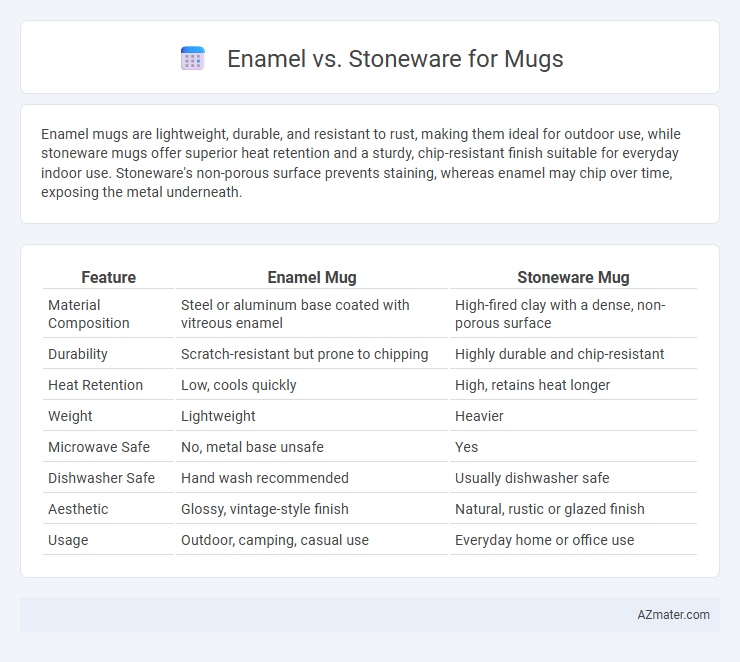Enamel mugs are lightweight, durable, and resistant to rust, making them ideal for outdoor use, while stoneware mugs offer superior heat retention and a sturdy, chip-resistant finish suitable for everyday indoor use. Stoneware's non-porous surface prevents staining, whereas enamel may chip over time, exposing the metal underneath.
Table of Comparison
| Feature | Enamel Mug | Stoneware Mug |
|---|---|---|
| Material Composition | Steel or aluminum base coated with vitreous enamel | High-fired clay with a dense, non-porous surface |
| Durability | Scratch-resistant but prone to chipping | Highly durable and chip-resistant |
| Heat Retention | Low, cools quickly | High, retains heat longer |
| Weight | Lightweight | Heavier |
| Microwave Safe | No, metal base unsafe | Yes |
| Dishwasher Safe | Hand wash recommended | Usually dishwasher safe |
| Aesthetic | Glossy, vintage-style finish | Natural, rustic or glazed finish |
| Usage | Outdoor, camping, casual use | Everyday home or office use |
Introduction to Enamel and Stoneware Mugs
Enamel mugs are crafted by fusing powdered glass to a metal base, creating a durable, lightweight, and heat-resistant surface ideal for outdoor use. Stoneware mugs are made from dense clay fired at high temperatures, offering excellent heat retention, a sturdy build, and a naturally rustic appearance. Both materials provide unique benefits, with enamel emphasizing portability and resilience, while stoneware highlights thermal insulation and aesthetic appeal.
Material Composition and Manufacturing Process
Enamel mugs consist of a metal core, typically steel or aluminum, coated with a layer of vitreous enamel that is fused through high-temperature firing, creating a durable, glossy finish resistant to rust and scratches. Stoneware mugs are crafted from dense, porous clay that is fired at high temperatures, resulting in a thick, heavy ceramic with natural insulating properties and a matte or glazed surface. The manufacturing of enamelware involves metal shaping and enamel coating, whereas stoneware production centers on clay molding, glazing, and kiln firing, each process imparting distinct durability and aesthetic qualities to the mugs.
Durability: Enamel vs Stoneware
Enamel mugs offer superior durability due to their metal core coated with a resilient enamel layer, making them resistant to chipping, cracking, and extreme temperature changes. Stoneware mugs, while sturdier than regular ceramic, are more prone to chips and cracks over time, especially when exposed to sudden temperature shifts. For long-lasting use and outdoor activities, enamel mugs provide enhanced durability compared to stoneware options.
Heat Retention and Coffee Temperature
Stoneware mugs excel in heat retention due to their thick, dense material, keeping coffee warmer for longer periods compared to enamel mugs. Enamel mugs, made from metal coated with porcelain enamel, heat quickly but also lose temperature faster, making them less ideal for maintaining hot coffee. For users prioritizing prolonged coffee temperature, stoneware provides superior insulation and comfort during drinking.
Weight and Handling Comfort
Enamel mugs are lightweight and durable, making them easy to carry and ideal for outdoor use, while stoneware mugs tend to be heavier, providing a solid, stable feel but potentially less comfort during extended handling. The thin metal construction of enamel contributes to quick temperature changes, which may affect grip comfort, whereas stoneware's thicker walls retain heat longer and offer a more insulated, comfortable hold. Choosing between enamel and stoneware depends on prioritizing portability and ruggedness versus weight and ergonomics in daily or camping scenarios.
Aesthetic Appeal and Design Options
Enamel mugs boast a vintage charm with glossy, smooth surfaces that enable vibrant colors and intricate patterns, making them ideal for rustic or retro aesthetics. Stoneware mugs offer a more natural, earthy look with muted tones and textured finishes, appealing to those seeking handcrafted or artisanal design options. Both materials provide diverse styles, but enamel excels in bright, bold designs, while stoneware emphasizes organic, tactile beauty.
Safety and Food Health Considerations
Enamel mugs are coated with a layer of porcelain fused to metal, making them non-porous, resistant to bacteria, and free from harmful chemicals like BPA, which ensures safe contact with hot beverages. Stoneware mugs, made from dense clay fired at high temperatures, also offer excellent food safety due to their non-toxic glaze and durability, preventing leaching of metals or toxins into drinks. Both materials are generally safe for daily use, but enamel should be checked for chips to avoid exposing the underlying metal, while stoneware's chemical resistance makes it ideal for acidic beverages.
Maintenance and Cleaning Requirements
Enamel mugs require gentle hand washing with mild soap to prevent chipping and rust, as abrasive cleaners can damage their glossy coating. Stoneware mugs are generally dishwasher safe and more resistant to scratches, but they can develop cracks or stains from prolonged exposure to harsh detergents or sudden temperature changes. Both materials benefit from regular cleaning immediately after use to maintain longevity and hygiene.
Price Comparison: Enamel vs Stoneware Mugs
Enamel mugs typically cost less than stoneware mugs due to their lightweight and inexpensive manufacturing materials, often ranging from $5 to $15. Stoneware mugs, made from high-quality ceramic with durable glazing, usually cost between $15 and $40, reflecting their sturdiness and design appeal. Price differences also stem from factors like craftsmanship, brand reputation, and additional features such as insulation or unique finishes.
Choosing the Right Mug for Your Lifestyle
Enamel mugs offer lightweight durability and a classic, rustic appeal, making them ideal for outdoor enthusiasts and campers who prioritize portability and resistance to damage. Stoneware mugs provide excellent heat retention and a heavier, more substantial feel, perfect for home or office use where comfort and insulation matter. Selecting the right mug depends on your daily routine, with enamel suited to active, on-the-go lifestyles and stoneware favored for cozy, stationary settings.

Infographic: Enamel vs Stoneware for Mug
 azmater.com
azmater.com